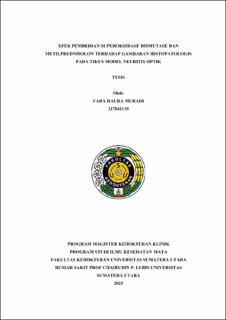Efek Pemberian Superoksidase Dismutase dan Metilprednisolon terhadap Gambaran Histopatologis pada Tikus Model Neuritis Optik
The Effects of Superoxide Dismutase and Methylprednisolone Administration on Histopathological Findings in a Rat Model of Optic Neuritis

Date
2025Author
Muradi, Fara Haura
Advisor(s)
Sitepu, Bobby Ramses Erguna
Delfi
Metadata
Show full item recordAbstract
Background: Optic neuritis (ON) is an idiopathic inflammatory demyelinating condition of the optic nerve, vulnerable to degeneration due to energy depletion, reactive oxygen species (ROS) accumulation, and mitochondrial dysfunction. Superoxide dismutase (SOD) may offer neuroprotective benefits by targeting redox dysregulation, helping to halt retinal and retinal ganglion cell (RGC) degeneration. When combined with methylprednisolone (MP), which reduces inflammation, this therapy may accelerate recovery and minimize optic nerve damage. The ASK1-p38 pathway further supports this combined mechanism.
Aim: To evaluate the effects of SOD and MP administration on optic nerve damage in a rat model of optic neuritis.
Methods: This was a randomized, post-test only, control group laboratory experiment involving five groups: sham, control (ON only), SOD (ON + 100 mg/kg/day), MP (ON + 30 mg/kg/day), and combination therapy (SOD 50 mg/kg/day + MP 15 mg/kg/day). Data were analyzed using One-Way ANOVA or Kruskal-Wallis test.
Results: The combination group demonstrated the most favorable outcomes, with the highest average RGC count (195 cells), minimal optic nerve edema (p<0.001), and demyelination levels similar to normal.
Conclusion: Combined administration of SOD and MP provided better histopathological outcomes—reflected in ganglion cell preservation, reduced edema, and minimal demyelination—than either treatment alone in this rat model of optic neuritis.
